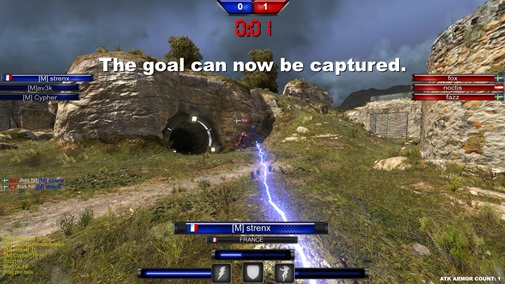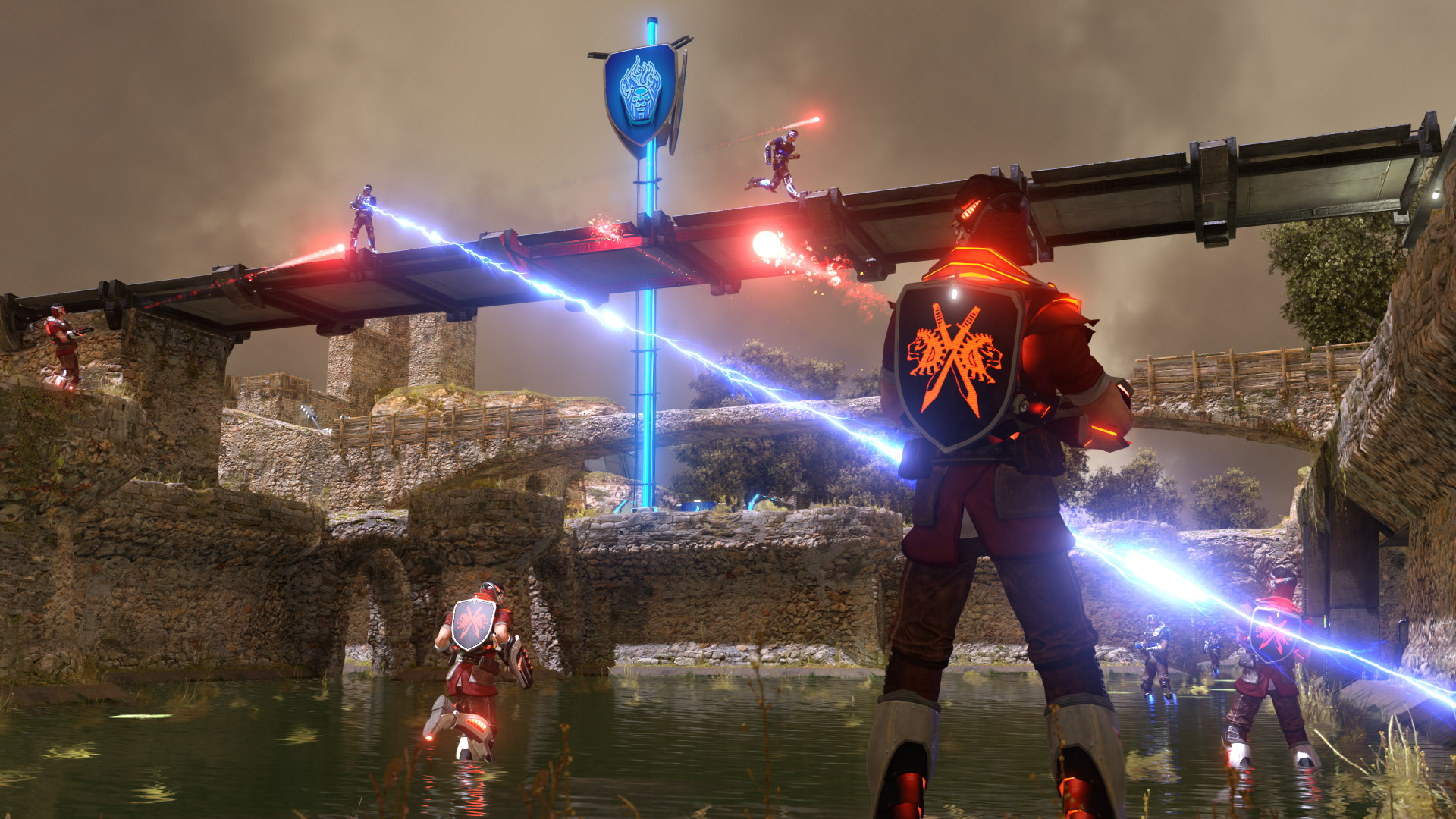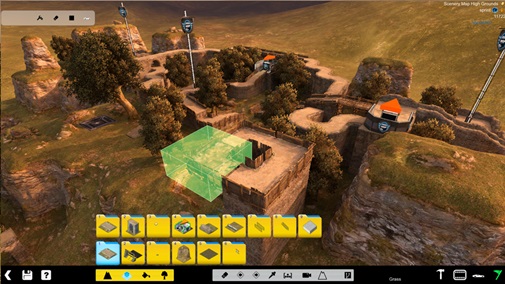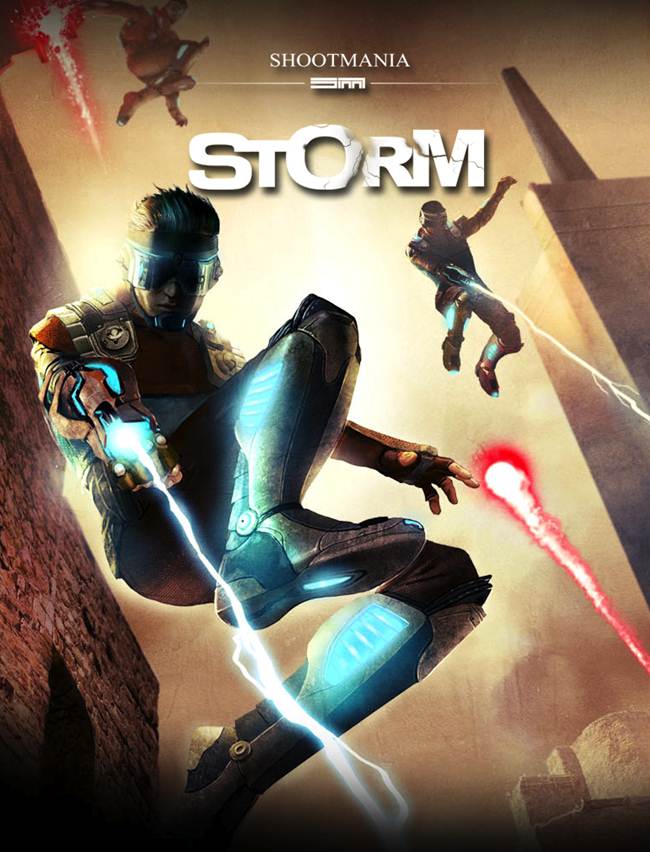
Like all good stories, this one begins many years ago. It was the summer of 2007, and a group of friends introduced me to Trackmania United. It was refreshing to have such a simple game provide such a deep experience and, though I didn’t have steady online access at the time, my friends and I got to grips with Trackmania’s editing tools in no time as we desparately tried to one up each other’s created tracks.
It was a fun summer full of Trackmania sessions, but Nadeo’s racing effort was defined more by its editing features than its actual gameplay. Whilst Trackmania was a fairly standard arcade racer outside of the social features, the company’s new online FPS exudes creativity from every pixel, providing one of the most exciting shooters I’ve played in years.
"Shootmania is one of the most skill-dependent shooters out there"
The basic mechanics are devilishly simple, comprising the WASD keys for movement and your two mouse buttons. That’s it. Left click to fire and your right mouse button functions as a jump when pressed and a sprint when held. It’s easy to pick up, but plenty of environmental factors all contribute to create a deep and varied shooter experience.
Your basic weapon of choice is a simple grenade launcher that, on account of its slow projectile and recharge time, requires you to lead your target somewhat. Considering the speed of basic character movement, this alone requires a great deal of skill and, as this wrist mounted cannon is your primary weapon, Shootmania becomes one of the most skill-dependent shooters out there.
It may sound boring only having one weapon, but it’s a versatile beast that changes based on your location/game mode. Entering a corridor will transform it into a two shot mine launcher, whilst standing on particular platforms turns it into a long range insta-kill sniper. That said, getting that one shot to connect is never as easy as it sounds.
The movement too is a suspiciously deep element of the game. Having only one button to jump and sprint means you need to hop before you can start sprinting but, as you are at your least mobile while in the air, jumping unnecessarily can be your demise. Add in frictionless speed platforms and jump pads, and you have a recipe for some very interesting game types and levels.
"The movement too is a suspiciously deep element of the game"
The stock content on Shootmania is varied and original enough with just these components. The default maps are mostly symmetrical, but offer enough choke points and vertical diversity to create interesting tactical scenarios regularly. The modes are even more engaging, totally disregarding the bog standard FPS modes that have retarded the genre for the past few years. Royale is the deathmatch equivalent, with everyone fighting to be the last man standing. The catch is the pole at the centre of the map that, when captured, summons a tornado that moves from the edge of the map inwards.
This force of nature wipes out any players caught up in it, turning long games into tense deathmatches in the centre of the level. Joust is the other non-team game, offering a simple one on one fight. The trick is that your weapons don’t recharge automatically like normal, forcing players to reach the weapon charge points at different ends of the map when they run out of ammo. It’s a very dynamic mode, but it’s certainly the weak link in the chain.
The team games get much more interesting. Battle pits two squads against each other to capture the three enemy zones. Unlike conventional capture modes though, the attacking and defending team switch every fifteen seconds unless a capture is actually taking place, making a game of constant back and forth. It’s a dynamic mode indeed, but the pace of it can take some serious getting used to. The most original mode is Elite, a three vs. three mode of attack and defence over a single point.
The twist is that the attacking team only sends one player out each time. To counter this, the attacker has a powerful one hit sniper as his default weapon, whilst the defenders only have the standard grenade launcher. It’s a beautifully balanced asymmetrical mode, and one that requires the utmost skill and teamwork. It’s also intense and often demanding because of this.
"A choice of a simplified editor allows new-comers to find their feet quickly, with this accessibility being furthered by the editor's similarly simple mouse button controls"
Whilst this may put some people off, capping the point at the last second as the lone attacker is some of the most exciting gaming I’ve done in ages. That said, this solo focus seems to be a recurring point in Shootmania’s stock modes, something that may put off those used to the flow of conventional team FPS games.
Where Shootmania gets really exciting is in its creation options. Already we’re seeing some crazy new game maps and modes, from siege game types to unconventional grappling hook-led platforming levels. The creation tools themselves are hugely accessible, allowing anyone to unleash this kind of creativity on the Shootmania community. A choice of a simplified editor allows new-comers to find their feet quickly, with this accessibility being furthered by the editor’s similarly simple mouse button controls.
As with the main game though, this simplicity is belied by just how much depth there is to Shootmania’s creation tools. These sharing elements make Shootmania’s longevity a given but, as with any game that relies on community content, the game’s long term success will hinge on the dedication of its community.
Shootmania’s games, editors and community are all wrapped up in a suspiciously decent front end program: Maniaplanet. Unlike the cavalcade of other game launchers that constantly download in the background and find other such ways to interfere (you know who you are), Maniaplanet launches quickly, efficiently and never goes behind your back.
The game’s visuals and clean menus also give Shootmania a slick aesthetic that reflects the refined game mechanics on offer. There are a few organisational problems with these menus though. Working out how to rearrange the Maniaplanet panels wasn’t exactly the most user friendly experience I’ve ever encountered, and the inability to sort game servers by players and ping is frustrating when you’re trying to find decent games at underpopulated times of day.
"Shootmania offers the tools necessary to allow for some awesome community generated content to flourish"
Despite a few interface hiccups, Shootmania offers the tools necessary to allow for some awesome community generated content to flourish. Unlike Trackmania though, the base modes and maps of Shootmania already offer more creativity and excitement than your average FPS effort, even without the promise of new content.
It’s a fantastic title that will likely keep giving if the community flourishes, though the onus placed on individual skill may put off those used to the ineffectual team play in Call of Duty style shooters. Still, you can’t beat the rush when it all goes to plan in a decent game of Shootmania Storm.
This game was reviewed on PC.
Refined gameplay, Interesting game modes, Decent interface, Potential for lots of custom content, More creative than your average online FPS, Great editors
Seems quite individual-focused at the moment, Lack of sever sorting options, Will live or die by its community



















